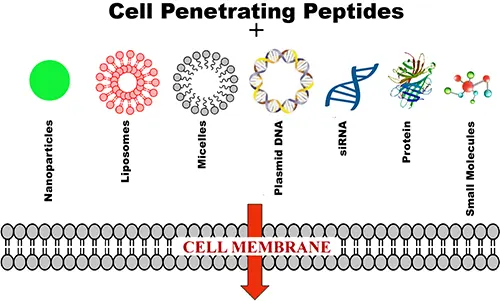
The process of introducing drugs into cells has always proved a major challenge for scientists. However, cell-permeable peptides (CPPs) have the ability to enter the plasma membrane of a cell independent of a membrane receptor. They are usually small peptides 10–30 residues in length with positively charged amino acid sequences.
CPPs are capable of delivering biologically active cargo to the cell interior. The desired therapeutic cargo could be attached to a CPP and then delivered to an intracellular target, thereby overcoming the entry restrictions set by the plasma membrane.
CPPs have gained widespread popularity as very promising non-viral transmembrane delivery vectors. Although they have been used successfully for carrying different cargoes of varying sizes and nature (plasmid DNA, peptides, proteins, nanoparticles, quantum dots, etc.), the most rapid progress has been made with the delivery of oligonucleotides (ONs).
| LT12005 | Stearyl-R8: Stearyl-RRRRRRRR-NH2 | |
| LT8163 | LMWP peptide VSRRRRRRGGRRRR | $280 In Stock |
| LT12013 | FITC-R8: FITC-Stearyl-RRRRRRRR | |
| LT35796 | C(Npys)-(Arg)9: C(Npys)RRRRRRRRR - NH2 | |
| LT1615 | TAT (47-57): YGRKKRRQRRR | |
| LT5549 | HIV-1 Tat (48-60): GRKKRRQRRRPPQ | |
| LT8227 | Cy3 labeled HIV-1 Tat (48-60) variant: Cy3-GISYGRKKRRQRRRAHQ |
$350 In Stock |
| LT8228 | FAM/TAMRA labeled HIV-1 Tat (48-60) variant: (5-FAM)-GISYGAKKRRQRRRAHQ-Cys(TAMRA) |
$350 In Stock |
We have a list of in-stock CPPs ready to conjugate with your targets. Your target can be a peptide, protein, fluorescent dye, or nanoparticle. Click for a full list of Cell Permeable Peptides.
| Antennapedia Peptide | RQIKIWFQNRRMKWKK; C(Npys)-RQIKIWFQNRRMKWKK; C-RQIKIWFQNRRMKWKK; RQIKIWFQNRRMKWKK-C; |
In Stock |
| Penetratin (GG linker) |
RQIKIWFQNRRMKWKK-GG; C-RQIKIWFQNRRMKWKK-GG; RQIKIWFQNRRMKWKK-GG-C; |
In Stock |
| Penetratin and Labeled Antennapedia peptides |
RQIRIWFQNRRMRWRR; C-RQIRIWFQNRRMRWRR; {FITC-LC}-RQIKIWFQNRRMKWKK; {5-FAM}-RQIKIWFQNRRMKWKK; {Cy3}-RQIKIWFQNRRMKWKK; {Cy5}-RQIKIWFQNRRMKWKK; {Alexa488}-RQIKIWFQNRRMKWKK; |
In Stock |
| (Arg)9 Oligomer peptides Fluorescent Labeling |
Stearyl-R8; FITC-Stearyl-R8; RRRRRRRRRC; C(Npys)RRRRRRRRR; HS-cR10: C-(mini-PEG)-(mini-PEG)-KRrRrRrRrRrE; C(Npys)rrrrrrrrr, r is D amino acid; {FAM}-RRRRRRRRR; {TAMRA}-RRRRRRRRR; {Biotin}-RRRRRRRRR; {Cy Dyes}-RRRRRRRRR; {Alexa Dyes}-RRRRRRRRR; |
In Stock |
| TAT (47-57) and Variants |
YGRKKRRQRRR ; C-YGRKKRRQRRR; VSRRRRRRGGRRRR; YGRKKRRQRRR-C; {Biotin}-YGRKKRRQRRR; {FAM}-YGRKKRRQRRR; {TAMRA}-YGRKKRRQRRR; YGRKKRRQRRRGGGC(Npys); C(Npys)YGRKKRRQRRR-K(FAM); MDYKDHDGDYKDHDIDYKDDDDK; |
In Stock |
| TAT GluR23 variants TAT-NSF222 Fusion Peptide TAT-NSF700 Fusion Peptide HIV-1 Tat (48-60) |
YGRKKRRQRRR; YGRKKRRQRRRYKEGYNVYG; YGRKKRRQRRRVYKYGGYNE; YGRKKRRQRRRAKEGANVAG; YGRKKRRQRRR GGG LDKEFNSIFRRAFASRVFPPE; YGRKKRRQRRR GGG ENSFRFLADIFPAKAFPVRFE; YGRKKRRQRRR GGG LLDYVPIGPRFSNLVLQALLVL; YGRKKRRQRRR GGG IPPVYFSRLDLNLVVLLLAQL; GRKKRRQRRRPPQ; Cy3-GISYGRKKRRQRRRAHQ; (5-FAM)-GISYGAKKRRQRRRAHQ-Cys(TAMRA); Cys-GRKKRRQRRRPPQ; GRKKRRQRRRPPQC; Cys-GRKKRRQRRR; RRRQRRKKRGGDIMGEWGNEIFGAIAGFLG; YGRKKRRQRRRKLSSIESDV; |
Crude Peptide In Stock, HPLC Purify in 5 Days |
|
Cell Permeable-Mastoparan Peptide NGR peptide, Aminopeptidase N Ligand (CD13) NGR Peptide 1 Anti-BetaGamma (MPS-Phosducin-like protein C terminus) Buforin 2 Rabies Virus Glycoprotein (RVG) Chimeric Rabies Virus Glycoprotein Fragment (RVG-9R) IKKgamma NEMO Binding Domain (NBD) Inhibitory Peptide KALA NF-kB Inhibitor, SN50 pVEC (Cadherin-5) SV40 Large T-antigen Nuclear Localization Signal (NLS) SV40 Large T-antigen Nuclear Localization Signal (NLS) derived peptide SV40 Large T-antigen Nuclear Localization Signal (NLS) Analog TfR Targeting Peptide Transdermal Peptide Transportan Pep-1 Pep-1-Cysteamine cardiac targeting peptide (CTP) |
INLKALAALAKKIL-NH2; |
Crude Peptide In Stock, HPLC Purify in 5 Days |
